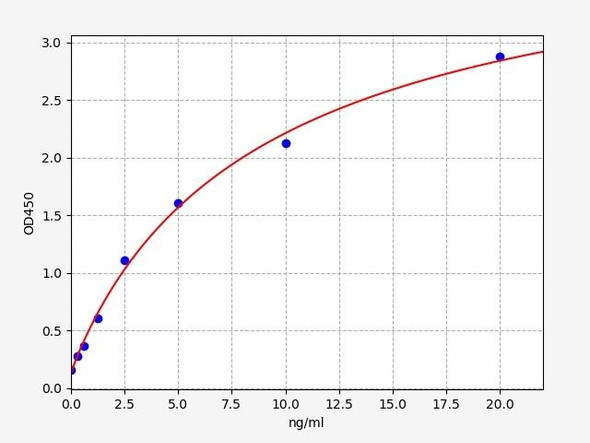Human TPH1(Tryptophan Hydroxylase 1)ELISA Kit (HUES03406)
- SKU:
- HUES03406
- Product Type:
- ELISA Kit
- Size:
- 96 Assays
- Uniprot:
- P17752
- Sensitivity:
- 0.19ng/mL
- Range:
- 0.31-20ng/mL
- ELISA Type:
- Sandwich
- Synonyms:
- Tryptophan hydroxylase 1 ,tryptophan 5-monooxygenase,TPH1,TPRH, TRPH
- Reactivity:
- Human
- Sample Type:
- Serum, plasma and other biological fluids
- Research Area:
- Neuroscience
Description
Human TPH1 (Tryptophan Hydroxylase 1) ELISA Kit
The Human TPH1 (Tryptophan Hydroxylase 1) ELISA Kit is specifically designed for the precise detection of TPH1 levels in human serum, plasma, and cell culture supernatants. This kit offers exceptional sensitivity and specificity, ensuring accurate and reproducible results, making it an invaluable tool for a variety of research endeavors.TPH1 is a key enzyme involved in the synthesis of serotonin, a neurotransmitter that plays a vital role in regulating mood, appetite, and sleep. Dysregulation of TPH1 and serotonin levels have been implicated in various psychiatric disorders, including depression, anxiety, and schizophrenia, highlighting the importance of TPH1 as a potential biomarker for studying these conditions and developing new treatment strategies.
Overall, the Human TPH1 ELISA Kit provides researchers with a reliable and efficient method for investigating the role of TPH1 in health and disease, offering valuable insights into the mechanisms underlying serotonin-related disorders and facilitating the development of targeted interventions.
| Assay type: | Sandwich |
| Format: | 96T |
| Assay time: | 4.5h |
| Reactivity: | Human |
| Detection Method: | Colormetric |
| Detection Range: | 0.31-20 ng/mL |
| Sensitivity: | 0.19 ng/mL |
| Sample Volume Required Per Well: | 100µL |
| Sample Type: | Serum, plasma and other biological fluids |
| Specificity: | This kit recognizes Human TPH1 in samples. No significant cross-reactivity or interference between Human TPH1 and analogues was observed. |
This ELISA kit uses Sandwich-ELISA as the method. The micro ELISA plate provided in this kit has been pre-coated with an antibody specific to Human TPH1. Standards or samples are added to the appropriate micro ELISA plate wells and combined with the specific antibody. Then a biotinylated detection antibody specific for Human TPH1 and Avidin-Horseradish Peroxidase (HRP) conjugate are added to each micro plate well successively and incubated. Free components are washed away. The substrate solution is added to each well. Only those wells that contain Human TPH1, biotinylated detection antibody and Avidin-HRP conjugate will appear blue in color. The enzyme-substrate reaction is terminated by adding Stop Solution and the color turns yellow. The optical density (OD) is measured spectrophotometrically at a wavelength of 450 nm ± 2 nm. The OD value is proportional to the concentration of Human TPH1. The concentration of Human TPH1 in samples can be calculated by comparing the OD of the samples to the standard curve.
| UniProt Protein Function: | TPH1: an enzyme that is rate-limiting in the biosynthesis of serotonin. It catalyzes the biopterin dependent monooxygenation of tryptophan to 5-hydroxytryptophan (5HT), which is subsequently decarboxylated to form the neurotransmitter serotonin. Its expression is limited to a few specialized tissues: raphe neurons, pinealocytes, mast cells, mononuclear leukocytes, beta-cells of the islets of Langerhans, and intestinal and pancreatic enterochromaffin cells. Two alternatively spliced isoforms have been described. |
| UniProt Protein Details: | Protein type:Amino Acid Metabolism - tryptophan; EC 1. 14. 16. 4; Oxidoreductase Chromosomal Location of Human Ortholog: 11p15. 3-p14 Cellular Component: cytosol Biological Process: indolalkylamine biosynthetic process |
| NCBI Summary: | This gene encodes a member of the aromatic amino acid hydroxylase family. The encoded protein catalyzes the first and rate limiting step in the biosynthesis of serotonin, an important hormone and neurotransmitter. Mutations in this gene have been associated with an elevated risk for a variety of diseases and disorders, including schizophrenia, somatic anxiety, anger-related traits, bipolar disorder, suicidal behavior, addictions, and others. [provided by RefSeq, Apr 2009] |
| UniProt Code: | P17752 |
| NCBI GenInfo Identifier: | 116242823 |
| NCBI Gene ID: | 7166 |
| NCBI Accession: | P17752. 4 |
| UniProt Secondary Accession: | P17752,O95188, O95189, Q16736, Q3KPG8, D3DQX6, |
| UniProt Related Accession: | P17752 |
| Molecular Weight: | 53,394 Da |
| NCBI Full Name: | Tryptophan 5-hydroxylase 1 |
| NCBI Synonym Full Names: | tryptophan hydroxylase 1 |
| NCBI Official Symbol: | TPH1 |
| NCBI Official Synonym Symbols: | TPRH; TRPH |
| NCBI Protein Information: | tryptophan 5-hydroxylase 1 |
| UniProt Protein Name: | Tryptophan 5-hydroxylase 1 |
| UniProt Synonym Protein Names: | Tryptophan 5-monooxygenase 1 |
| Protein Family: | Tryptophan 5-hydroxylase |
| UniProt Gene Name: | TPH1 |
| UniProt Entry Name: | TPH1_HUMAN |
As the OD values of the standard curve may vary according to the conditions of the actual assay performance (e. g. operator, pipetting technique, washing technique or temperature effects), the operator should establish a standard curve for each test. Typical standard curve and data is provided below for reference only.
| Concentration (ng/mL) | O.D | Average | Corrected |
| 20 | 2.318 2.33 | 2.324 | 2.25 |
| 10 | 1.512 1.548 | 1.53 | 1.456 |
| 5 | 0.836 0.81 | 0.823 | 0.749 |
| 2.5 | 0.466 0.504 | 0.485 | 0.411 |
| 1.25 | 0.257 0.247 | 0.252 | 0.178 |
| 0.63 | 0.179 0.155 | 0.167 | 0.093 |
| 0.31 | 0.116 0.128 | 0.122 | 0.048 |
| 0 | 0.066 0.082 | 0.074 | -- |
Precision
Intra-assay Precision (Precision within an assay): 3 samples with low, mid range and high level Human TPH1 were tested 20 times on one plate, respectively.
Inter-assay Precision (Precision between assays): 3 samples with low, mid range and high level Human TPH1 were tested on 3 different plates, 20 replicates in each plate.
| Intra-assay Precision | Inter-assay Precision | |||||
| Sample | 1 | 2 | 3 | 1 | 2 | 3 |
| n | 20 | 20 | 20 | 20 | 20 | 20 |
| Mean (ng/mL) | 1.11 | 2.02 | 7.04 | 1.10 | 2.04 | 7.57 |
| Standard deviation | 0.07 | 0.10 | 0.33 | 0.06 | 0.11 | 0.36 |
| C V (%) | 6.31 | 4.95 | 4.69 | 5.45 | 5.39 | 4.76 |
Recovery
The recovery of Human TPH1 spiked at three different levels in samples throughout the range of the assay was evaluated in various matrices.
| Sample Type | Range (%) | Average Recovery (%) |
| Serum (n=5) | 93-110 | 100 |
| EDTA plasma (n=5) | 87-97 | 92 |
| Cell culture media (n=5) | 89-101 | 96 |
Linearity
Samples were spiked with high concentrations of Human TPH1 and diluted with Reference Standard & Sample Diluent to produce samples with values within the range of the assay.
| Serum (n=5) | EDTA plasma (n=5) | Cell culture media (n=5) | ||
| 1:2 | Range (%) | 97-108 | 91-104 | 89-103 |
| Average (%) | 102 | 98 | 95 | |
| 1:4 | Range (%) | 92-105 | 79-92 | 89-101 |
| Average (%) | 97 | 85 | 95 | |
| 1:8 | Range (%) | 91-107 | 82-97 | 85-101 |
| Average (%) | 98 | 88 | 92 | |
| 1:16 | Range (%) | 93-103 | 88-99 | 81-93 |
| Average (%) | 98 | 93 | 88 |
An unopened kit can be stored at 4°C for 1 month. If the kit is not used within 1 month, store the items separately according to the following conditions once the kit is received.
| Item | Specifications | Storage |
| Micro ELISA Plate(Dismountable) | 8 wells ×12 strips | -20°C, 6 months |
| Reference Standard | 2 vials | |
| Concentrated Biotinylated Detection Ab (100×) | 1 vial, 120 µL | |
| Concentrated HRP Conjugate (100×) | 1 vial, 120 µL | -20°C(shading light), 6 months |
| Reference Standard & Sample Diluent | 1 vial, 20 mL | 4°C, 6 months |
| Biotinylated Detection Ab Diluent | 1 vial, 14 mL | |
| HRP Conjugate Diluent | 1 vial, 14 mL | |
| Concentrated Wash Buffer (25×) | 1 vial, 30 mL | |
| Substrate Reagent | 1 vial, 10 mL | 4°C(shading light) |
| Stop Solution | 1 vial, 10 mL | 4°C |
| Plate Sealer | 5 pieces | |
| Product Description | 1 copy | |
| Certificate of Analysis | 1 copy |
- Set standard, test sample and control (zero) wells on the pre-coated plate and record theirpositions. It is recommended to measure each standard and sample in duplicate. Note: addall solutions to the bottom of the plate wells while avoiding contact with the well walls. Ensuresolutions do not foam when adding to the wells.
- Aliquot 100µl of standard solutions into the standard wells.
- Add 100µl of Sample / Standard dilution buffer into the control (zero) well.
- Add 100µl of properly diluted sample (serum, plasma, tissue homogenates and otherbiological fluids) into test sample wells.
- Cover the plate with the sealer provided in the kit and incubate for 90 min at 37°C.
- Aspirate the liquid from each well, do not wash. Immediately add 100µL of BiotinylatedDetection Ab working solution to each well. Cover the plate with a plate seal and gently mix. Incubate for 1 hour at 37°C.
- Aspirate or decant the solution from the plate and add 350µL of wash buffer to each welland incubate for 1-2 minutes at room temperature. Aspirate the solution from each well andclap the plate on absorbent filter paper to dry. Repeat this process 3 times. Note: a microplatewasher can be used in this step and other wash steps.
- Add 100µL of HRP Conjugate working solution to each well. Cover with a plate seal andincubate for 30 min at 37°C.
- Aspirate or decant the solution from each well. Repeat the wash process for five times asconducted in step 7.
- Add 90µL of Substrate Reagent to each well. Cover with a new plate seal and incubate forapproximately 15 min at 37°C. Protect the plate from light. Note: the reaction time can beshortened or extended according to the actual color change, but not by more than 30min.
- Add 50 µL of Stop Solution to each well. Note: Adding the stop solution should be done inthe same order as the substrate solution.
- Determine the optical density (OD value) of each well immediately with a microplate readerset at 450 nm.






